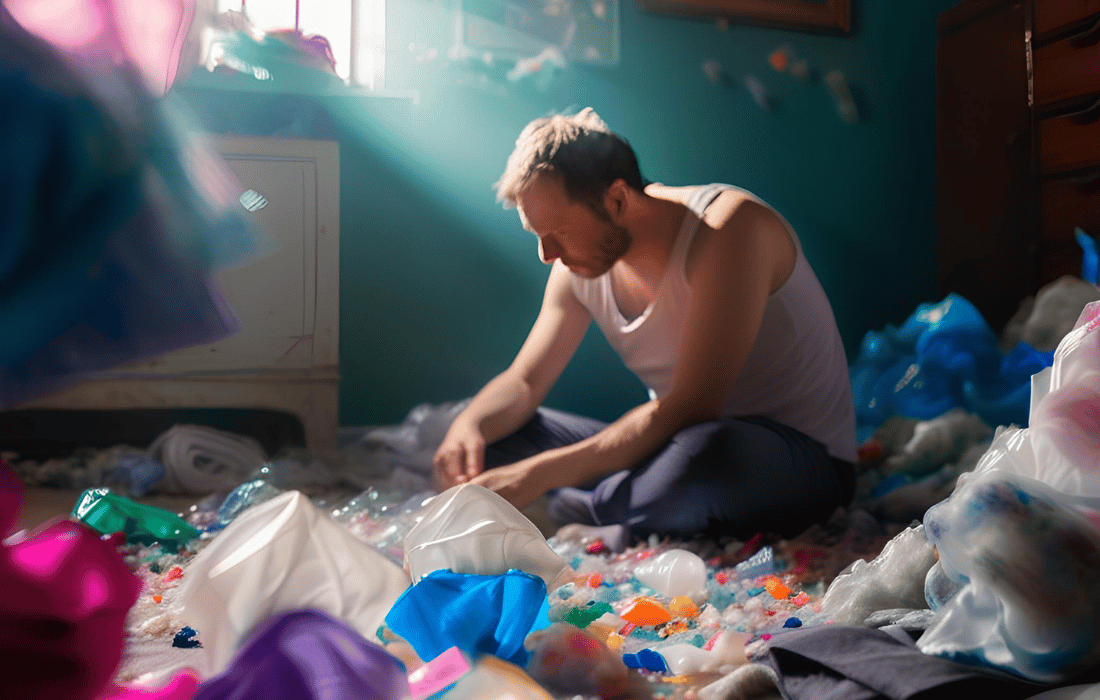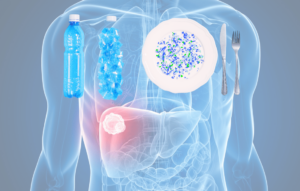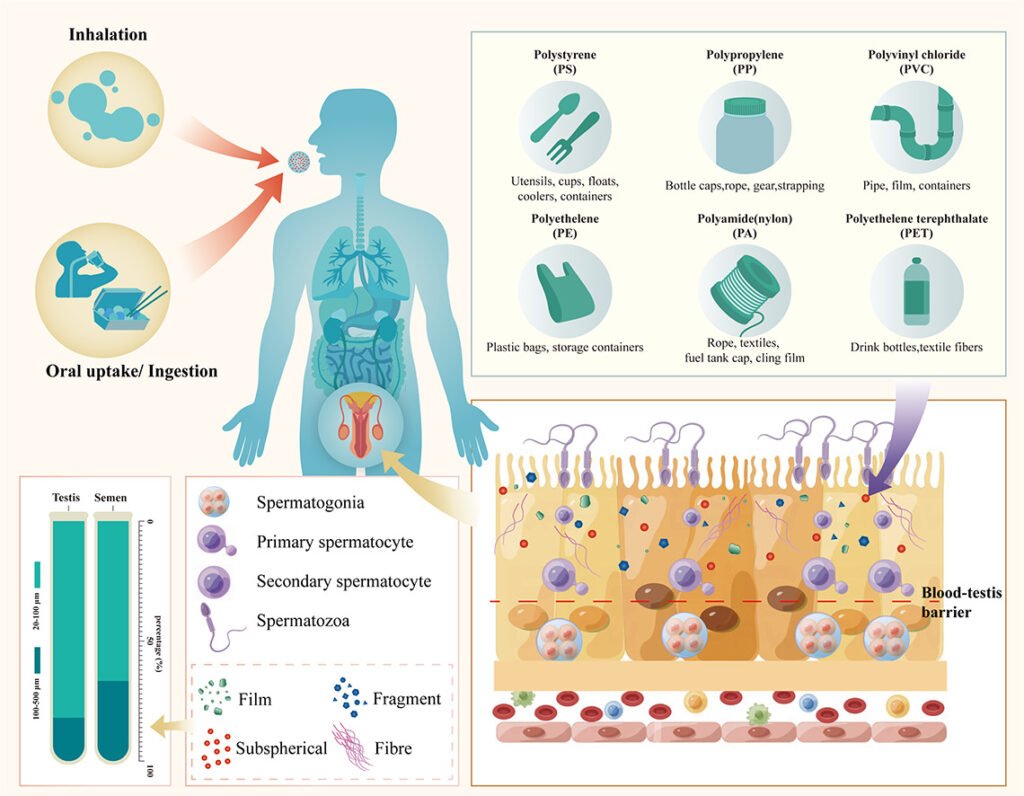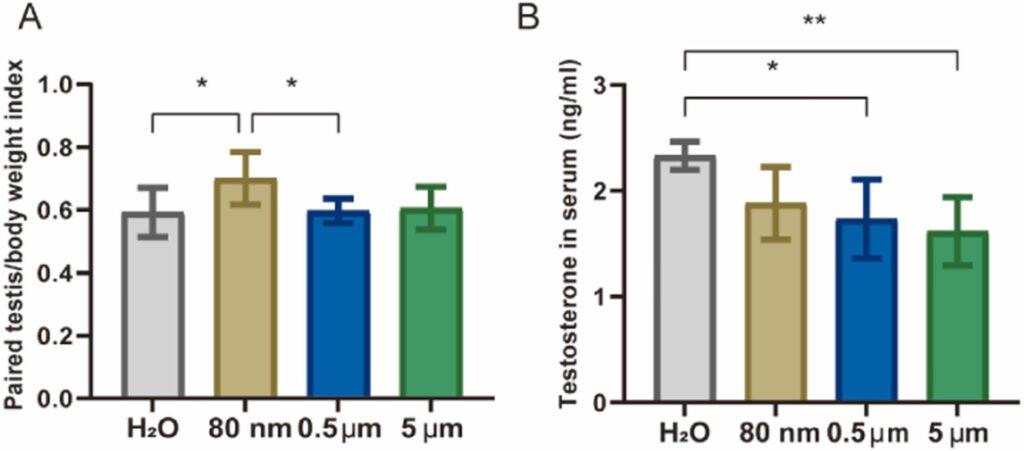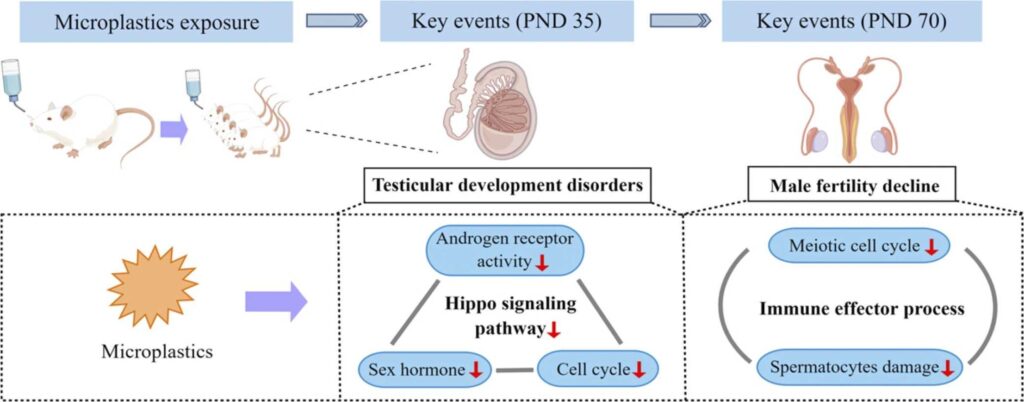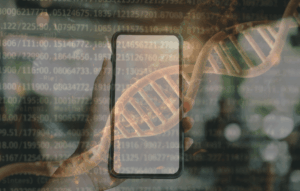We live in an age of plastic convenience—grocery bags, water bottles, food packaging, foam cups—the list goes on. But there’s a catch: these plastics break down into ever-smaller fragments called microplastics (MPs), which we unwittingly eat, drink, and breathe. Disturbingly, mounting evidence suggests these sneaky plastic bits have infiltrated one of the most sacred male body parts: the testicles.
Multiple cutting-edge studies—like the one by Zhao et al. (2023)—verify that microplastics aren’t just an environmental plague; they’re lodging themselves inside our bodies. Specifically, Zhao’s team found microplastics in both testis and semen samples, with far higher microplastic abundance in testis (11.60 ± 15.52 particles/g) than in semen (0.23 ± 0.45 particles/mL). To make matters worse, polystyrene (PS) dominated in the testis, while polyethylene (PE) and polyvinyl chloride (PVC) topped the list in semen.
Where Microplastics Come From—and How They Get Inside You
Microplastics come from virtually everywhere in modern society. They originate from:
Plastic Bottles & Food Packaging – Degraded plastic leeches into food and drinks, especially under heat exposure.
Clothing & Textiles – Polyester, nylon, and synthetic blends shed microfibers during washing and wearing.
Personal Care Products – Microbeads in exfoliants, toothpaste, and cosmetics introduce MPs through direct skin absorption.
Tap Water & Bottled Water – Studies show that both sources contain substantial amounts of microplastics.
Seafood – Fish and shellfish often contain MPs due to oceanic contamination.
Household Dust – Indoor environments, filled with synthetic carpets and furniture, contribute significantly to airborne MPs.
Routes of Microplastic Absorption
How do these minuscule plastic particles wind up lurking in our nether regions? For one, microplastics are smaller than 5mm—and often as small as a single micron—enabling them to fly under the radar in daily life. We encounter them from:
Ingestion – Consuming contaminated food, water, or inhaled dust that settles on meals.
Inhalation – Breathing in airborne microplastics from synthetic textiles, furniture, and car interiors.
Dermal Absorption – Skin exposure to microplastics from personal care products, synthetic clothing, or contaminated water.
Once inside, they can navigate through blood circulation to organs such as the lungs, liver, placenta, and, as research now shows, the male reproductive tract. PE, PS, polyester—these polymers have all been detected in various human tissues, pointing to an extensive infiltration of our biology by plastic debris.
How Microplastics Sabotage Male Fertility
Microplastics pose a silent but significant threat to male reproductive health, infiltrating critical tissues and causing systemic disruptions. This invasion is more insidious than previously recognized, affecting various organs and especially accumulating within reproductive tissues such as the testes.
Global Decline of Fertility: Microplastics as a New Suspect
Fertility experts have observed a troubling decline in sperm counts globally over recent decades. Traditional explanations often point to lifestyle, pollution, or endocrine-disrupting chemicals. However, microplastics have emerged as a critical new suspect, accumulating within testicular tissue and semen, disrupting vital biological processes for reproductive health. Microplastics’ endocrine-disrupting properties enable them to mimic or block natural hormones, significantly exacerbating fertility issues and adding urgency to understanding and addressing this pollutant.
Microplastics in the Testicles (and Beyond)
Alarmingly, recent studies have confirmed the presence of microplastics directly within human testicular tissue. These microplastic particles not only infiltrate testicles but have also been detected throughout other critical organs including the brain, gut microbiome, bone marrow, heart, and lungs. Their pervasive nature underscores the severity of contamination, raising major health concerns about their cumulative and long-term impacts on fertility and overall bodily function.
Microplastics disrupt male reproductive health through a complex interplay of harmful mechanisms:
Oxidative Stress Frenzy: Microplastics accelerate the production of reactive oxygen species (ROS), damaging DNA, proteins, and cell membranes within testicular tissues. This oxidative assault significantly compromises sperm quality, reducing motility, viability, and overall reproductive potential.
Inflammatory Chain Reaction: Once microplastics infiltrate testicular tissue, they trigger an immune response marked by chronic inflammation. The release of inflammatory chemicals damages tissues essential for sperm production, potentially leading to reduced testicular size, impaired sperm development, and diminished fertility.
Blood-Testis Barrier Breach: The blood-testis barrier is critical in safeguarding sperm from harmful toxins and immune attacks. Studies demonstrate that polystyrene microplastics compromise this barrier, allowing hazardous substances direct access to sperm-producing cells. This breach further exacerbates inflammation and cellular damage within the testes.
Hormone Havoc and Testosterone Decline: Testosterone is crucial for maintaining male reproductive health, influencing everything from libido to sperm production. Unfortunately, microplastics disrupt the hormonal balance by interfering with Leydig cells, which produce testosterone, and by altering the secretion of key reproductive hormones such as luteinizing hormone (LH) and follicle-stimulating hormone (FSH). This disruption ultimately leads to decreased testosterone production and diminished fertility.
5. Cellular Aging & Senescence: Recent research underscores the alarming impact of microplastics in accelerating testicular aging. Chronic exposure, particularly to polystyrene microplastics, induces mitochondrial dysfunction, causing premature senescence (cellular aging) in testicular cells. Accelerated aging significantly undermines long-term fertility, posing a dire threat to reproductive longevity.
6. Structural Damage & Altered Cell Function: Microplastics embed themselves directly into Sertoli cells—responsible for nurturing sperm cells—and Leydig cells—critical for testosterone production. This intrusion impairs their ability to function normally, severely impacting sperm quality and hormone levels.
7. Altered Gene Expression: Microplastics have been found to disrupt the expression of genes vital for steroid hormone biosynthesis, interfering with the body’s natural hormonal regulation. This disruption further contributes to reproductive dysfunction and fertility challenges.
Oxidative Stress, Ca²⁺ Overload, and Mitochondrial Mayhem
Recent investigations into microplastics like polystyrene and polyethylene highlight deeper mechanisms:
Mitochondrial Dysfunction: Microplastics cause calcium (Ca²⁺) overload in mitochondria, collapsing membrane potentials and amplifying ROS.
Impaired Mitophagy: Cells can’t properly recycle broken mitochondria, leading to a backlog of cellular junk.
NF-κB Overactivation: This inflammation-driving protein ramps up, sparking a pro-inflammatory environment that’s devastating to sperm development.
Anogenital Distance: A Marker of Endocrine Disruption
A crucial but often overlooked indicator of endocrine disruption caused by microplastics and other pollutants is the anogenital distance (AGD)—the length measured between the anus and the genitals. This seemingly minor anatomical measurement carries significant implications for male reproductive health.
Understanding the Importance of AGD
AGD is typically longer in males than in females and is considered a reliable biomarker for prenatal exposure to endocrine-disrupting chemicals (EDCs). A shorter AGD in males has been linked to compromised reproductive health outcomes, such as reduced sperm count, lower testosterone levels, and increased risk of reproductive disorders later in life.
Microplastics and AGD: Emerging Evidence
Recent research highlights microplastics’ potent endocrine-disrupting potential, influencing hormonal pathways crucial for sexual differentiation. Prenatal and early-life exposure to microplastics can mimic estrogenic activity, leading to hormonal imbalance and altering critical developmental processes, including the establishment of AGD.
Studies indicate that exposure to microplastic particles, such as phthalate-laden plastics, is significantly associated with shorter AGD in male offspring. These changes in AGD are direct manifestations of hormonal disruptions that could predispose affected individuals to reproductive health issues like reduced sperm quality and compromised testosterone production as adults.
The alteration of AGD due to microplastic-induced endocrine disruption is more than just a developmental anomaly. It signals potential lifelong reproductive health challenges. Shortened AGD is associated with fertility difficulties, lower semen quality, and hormonal imbalances, underscoring the urgency of addressing microplastic pollution as a serious environmental and public health issue.
Polyester: The Hidden Threat in Your Wardrobe
Polyethylene and polystyrene microplastics typically take center stage, but polyester, found in clothing and textiles, might be just as concerning. Washing synthetic fabrics releases polyester fibers that drift into waterways, cycle into the food chain, and ultimately land in our bodies.e
When it comes to male reproductive health, polyester microplastics:
Incite oxidative stress and inflammatory signals
Upset hormonal regulation, fueling imbalances
Potentially accumulate more stubbornly in tissues
The synthetic gym attire you love for its moisture-wicking qualities could be introducing unseen fibers into your bloodstream—and, quite possibly, your testicles.
How to Avoid and Detoxify Microplastics
Cutting Down Exposure
While it’s impossible to eliminate microplastics entirely, reducing exposure can make a significant difference:
Eliminate Plastic in Food & Drink Storage – Opt for glass, stainless steel, or ceramic instead of plastic bottles and containers.
Ditch Polyester & Synthetic Fabrics – Wear organic cotton, hemp, or wool, especially for underwear and clothing that comes into direct contact with skin.
Upgrade Your Personal Care Products – Avoid anything containing microbeads or plastic-based exfoliants. VanMan is a great option for tallow-based soap, moisturizer, eggshell toothpaste, etc.
Be Mindful of Seafood Consumption – Since seafood is a major source of microplastic ingestion, prioritize wild-caught fish from less polluted waters.
Filter Your Water – Use a high-quality reverse osmosis with an activated carbon filter to remove plastic particles from drinking water.
Control Indoor Air Quality – Reduce indoor dust by using HEPA air filters and vacuuming with a HEPA-filtered vacuum.
Wash Clothes Smartly – Use a microfiber-catching bag or washing machine filter to trap synthetic fibers.
Detox Strategies for Microplastic Accumulation
Once microplastics are inside, the body needs help flushing them out:
Sweat It Out – Regular sauna and sweating sessions promote detoxification by mobilizing plastic particles and other toxins stored in fat cells.
- Support Gut Health – Certain strains of Bifidobacterium and Lactobacillus probiotics have been proven to remove microplastics from the gut while repairing the gut wall. Use code “KYLETOTHEMOON” to save 10% on Jigsaw’s Essential Blend Probiotics, which contains all strains proven to have a positive detoxification effect on microplastics.
Consume Sulforaphane – Found in cruciferous vegetables like broccoli sprouts, sulforaphane aids in detoxification.
Use Natural Binders – Supplements like chlorella, spirulina, and activated charcoal can help bind and remove plastics from the digestive tract.
Increase Antioxidant Intake – Vitamins C and E, glutathione, and polyphenols combat oxidative stress caused by microplastic exposure.
Eat Fiber-Rich Foods – Fiber helps push out toxins and plastics from the gut, reducing long-term retention.
Summary: Don’t Let Plastic Grab You by Your Balls
Let’s face it: microplastics have become a permanent fixture in our environment, and data shows they’re increasingly worming their way into the male reproductive system. These tiny plastic particles can cause oxidative damage, inflame tissues, disrupt hormones, and even accelerate cellular aging—none of which bode well for fertility.
But it’s not all doom and gloom. Protective measures can curb daily exposure, from filtration systems to mindful laundry habits. Meanwhile, natural antioxidant defenders—like luteolin—offer a promising avenue to counteract microplastic-induced damage, preserving sperm quality and hormone balance.
Ultimately, the problem of microplastics goes beyond a simple annoyance; it’s a profound threat to men’s health—and the health of future generations. By staying informed, minimizing plastic use, exploring dietary remedies, and supporting more rigorous research, you can defend your “family jewels” against these barely visible yet menacing intruders. After all, your balls are worth the effort—and the planet will thank you too.

